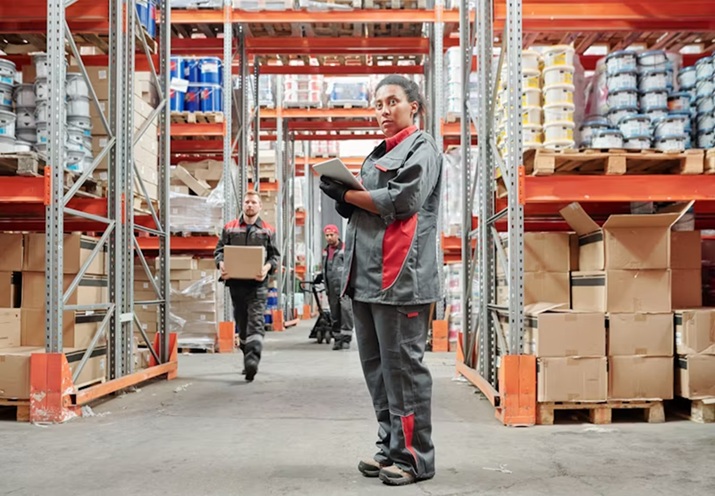What Is Cross-Docking?
Cross docking is the relocation of intact pallets from one method of ground transportation, such as rail or truck, to another without any storage time in between. Freight forwarders consolidate shipments with the same next stop (end-to-end supply chain management) at a facility before loading them onto containers for off-loading to the port of entry.
Then, they’re reloaded onto outbound trucks or railway cars to continue their trip. Larger shipments may be consolidated into smaller portions for lower cost and faster delivery. Similarly, as goods move to the same destination, they may be trucked together in fewer last-mile vehicles, further reducing carbon emissions.
We’ll talk later about the companies that benefit the most from cross-docking.
What Is The Difference Between Cross-Docking and Warehousing?
In order to understand the difference between cross-docking and warehousing, let’s first review what warehousing is all about.
Advancements in logistics are leading strategists and supply chain managers to look at traditional warehouses as a problem. They see all the things in the background like labor costs, motion waste, inventory management, and more.
Where once warehouses were seen as efficient and necessary, things are not so simple anymore. Nowadays, warehousing is seeing dramatically increased costs when it comes to labor, storage space, heating and lighting, insurance, and taxes.
Now these advancements have also reduced the need for large quantities of stock. Taking advantage of buffer stock or even skipping inventory altogether is becoming more popular thanks to “Just-in-Time Manufacturing”, also known as “Lean Manufacturing”.
But a cross-docking warehouse is a bit different than all that. In a hub-and-spoke distribution network, the warehouse or distribution center is the “hub” in a cross-docking situation. The products are quickly identified, organized, and sent to trucks bound for various locations all over. Companies are efficiently reducing both inventory and material handling in their warehouses.
Cross Dock Warehouse Distribution
Most cross-docking takes place at a warehouse or distribution docking terminal, where trucks are constantly entering and leaving. There are generally two distinct areas for inbound and outbound shipments, with a middle area for arranging and packing products.
Shipment refers to the arrival of goods into a facility from a vehicle, ship, or airliner. All the items in the middle get moved so that they can be sorted and inspected. Packaged products are sent on outbound transport to be delivered to customers.
The majority of shipments spend less than 24 hours in a cross-dock before being sent to their final destinations. This greatly reduces the time products spend in transit, and also reduces the amount of inventory a company needs to maintain. Cross-docking is therefore very popular with companies that distribute perishables, or that have very high inventory turnover rates.
In the past, these companies would have needed large warehouses to store all their products, but cross-docking warehouses have changed that. It’s a lot easier and cheaper to keep track of goods if they’re constantly moving, rather than sitting in storage.
The Benefits of a Cross-Docking Warehouse
Reduces Storage Space
In a cross-docking warehouse, products are only stored for a very short time before being shipped out again. This frees up a lot of space that would otherwise be used for storage.
Reduces Labor Costs
In a traditional warehouse, products have to be picked off the shelves and packed into boxes for shipping. In a cross-docking warehouse, this labor-intensive process is unnecessary since the products are already sorted and organized.
Reduces Shipping Costs
Cross-docking warehouses are designed for efficiency, which means that products spend less time in transit. This reduces shipping costs and allows companies to provide faster delivery times to their customers.
Reduces the Price of What Were Once Fixed Costs
Things like equipment, utilities, and building rent can become variable costs. This is because a cross-docking warehouse requires less equipment, uses less energy, and often takes up less space.
Reduces Damage From the Handling of Materials
In a traditional warehouse, products are often moved around multiple times before they’re finally shipped out. This constant handling can lead to damage, but in a cross-docking warehouse, products are only handled once.
Improved Service
Since customers are receiving products faster at a lower cost with minimal damage, their experience is improved. This can lead to repeat business and an improved reputation for the company and is particularly crucial in B2B environments with contracts in place.
Improves Inventory Management
In a cross-docking warehouse, products are constantly moving and there is less need for buffer stock. Since products are only stored for a very short time, it’s easier to keep track of inventory and ensure that products are shipped out as soon as they’re received. This “just in time” inventory system helps to reduce waste and improve efficiency.
Increases Quality of Products
When cross-docking, it’s easy for items to be inspected before they’re shipped out. This helps to ensure that only high-quality products are delivered to customers.
Types of Cross-Docking
There are a number of cross-docking possibilities available to warehouse management. Companies will use the type of cross-docking that is appropriate for the items being handled.
Here are the major types:
Distributor Cross-Docking
This procedure combines different vendor items into a combined product pallet, which is delivered to the client as soon as the final item arrives. Various manufacturers could supply beauty goods to a distributor, who may then combine them into a single package for the customer.
Manufacturing Cross-Docking
In this process, purchased and inbound goods that are needed by manufacturing are handled. In this scenario, there might be a warehouse that receives products and is able to prepare sub-assemblies for all of the production orders.
Retail Cross-Docking
Many businesses, particularly those with a retail presence and large inventories, turn to this method. It entails the receipt of goods from several suppliers and then sorting everything onto outbound trucks for multiple stores. Walmart is a famous example of a company that utilized this specific method of cross docking warehouse in the ’80s.
They would take two types of products, one being a staple stock (something that is sold consistently throughout the year), as well as large amounts of products that are not sold much throughout the year. Direct freight is the term for this second type of procurement. By doing this, they minimize warehouse costs and keep inventory for as little time as possible.
Transportation Cross-Docking
To obtain economies of scale, this operation mixes shipments from numerous carriers in the less-than-truckload (LTL) and small packages.
Opportunistic Cross-Docking
It’s possible to use this strategy in any warehouse. The responsibility of delivering goods to customers as soon as possible is known as “fulfillment” in the transportation industry. This involves moving a product from the receiving dock to the outbound shipping dock as quickly as possible to meet purchase requirements.
What Types of Businesses are Suited for Cross-Docking?
There are many different types of businesses that can benefit from cross-docking. Any business that wants to improve efficiency, reduce costs, and ship products faster can implement cross-docking.
Cross-docking is ideal for merchants that have these types of goods:
Perishable Goods That Can’t Sit for Long Periods of Time
If you are shipping fresh produce, seafood, meat, or other perishables, cross-docking can help to get your products to customers quickly, while they are still fresh. Nowadays, customers are increasingly interested in buying local and organic produce, so being able to get these products to them quickly is crucial.
High-Value Goods That Are Easy to Damage
If you sell products that are easy to damage, such as glassware or electronics, cross-docking can help to reduce the risk of damage by reducing the amount of time that your goods spend in transit. With less time spent in transit, there is a lower chance that your products will be damaged. Also, fewer hands handling your products is another way to ensure this.
Low-Volume, High-Variety Goods
If you sell products that come in a large variety of SKUs but have low volume, such as clothing or shoes, cross-docking can help to reduce the amount of time that your goods spend in storage in addition to having much less stock taking up precious space.
Seasonal Goods
If you sell products that are only in demand at certain times of the year, such as Halloween costumes or Christmas decorations, cross-docking distribution can help you to ship your goods quickly and efficiently, without having to store them for long periods of time.
Orders From Another Warehouse That Are Pre-Picked and Pre-Packaged
Cross-docking can get orders to customers quickly and efficiently even after items are pre-picked and pre-packaged by a different warehouse altogether. This is because cross-docking allows you to bypass the need for your products to be stored in your warehouse, and instead, they can be shipped out as soon as they arrive.
High-Quality Items That Do Not Require Quality Inspections Throughout the Shipping Process
If you sell high-quality items that do not require quality inspections throughout the shipping process, cross-docking can be very beneficial. Quality inspections can slow down the shipping process, so by cross-docking, you can bypass this step and get your products to customers more quickly.
Products With a Predictable and Consistent Rate of Purchase
If you sell products that have a predictable and consistent rate of purchase, cross-docking can help to ensure that your products are always in stock and that you can meet customer demand. After all, these staple products are the lifeblood of stores.
Conclusion
Cross-docking is a great way to improve efficiency, reduce costs, and ship products faster. It’s the new way of doing things, and more and more businesses are starting to implement it. If you have the right type of products, cross-docking may be something you should consider for your business.
Do you think cross-docking is something that would benefit your business? Let us know in the comments below.
Frequently Asked Questions
Cross-docking is a logistics procedure where incoming shipments are promptly unloaded and loaded onto outbound trucks, rather than being stored in a warehouse. This can be done with little or no handling of the products themselves, which can save time and money.
Cross-docking typically involves three main steps: receiving, sorting, and shipping. In the receiving step, products are unloaded from inbound trucks and brought into the facility. In the sorting step, products are sorted according to their destination. And in the shipping step, products are loaded onto outbound trucks according to their destination.
Cross-docking can save time and money by reducing handling and storage costs. It can also improve stock turnover and reduce inventory levels. This is due to the fact that products spend less time in the facility, and are not stored for long periods of time. In addition, cross-docking can improve customer service levels by reducing lead times.
Cross-docking can be difficult to implement and manage. It requires coordination among different parties, including transportation carriers, suppliers, manufacturers, and retailers. There is also a risk of product damage and delays if the process is not managed properly. This is why it’s important to work with a professional company like Spectra.
HIPAA compliant mailing involves sending mail that involves personal data (PHI) that falls under HIPAA’s oversight. This includes but is not limited to health conditions, medical equipment, social security numbers, fingerprints, phone numbers, etc. Whether you’re sending invoices, statements, explanations of benefits or coverages, it doesn’t matter. It’s all protected and secure with Spectra. Not all direct mail fulfillment providers are HIPAA compliant.
Cross-docking may be a good solution for your business if you have a high volume of shipments and you need to get products to market quickly. It’s also a good solution if you have limited storage space and need to reduce inventory levels.
In traditional warehousing, products are stored in a warehouse until they are needed. This can be costly and time-consuming. In contrast, cross-docking involves unloading products from inbound trucks and loading them onto outbound trucks, without storing them in a warehouse. This can save time and money.
There is always a risk of product damage and delays when transporting goods. However, this risk can be minimized by working with a professional company like Spectra. We have a respectable reputation for solving complex supply chain challenges.
The answer to this question depends on your specific needs. If you have a high volume of shipments and you need to get products to market quickly, then cross-docking may be a good solution for you. Ultimately, the decision depends on your specific needs and goals.
If you’re interested in using cross-docking for your business, we can help. We have a team of logistics experts who can help you develop a cross-docking solution that meets your specific needs. Contact us today to get started.



20 thoughts on “Cross Docking Warehouse: Everything You Need to Know”
I read your blog and I’m still trying to figure out exactly what cross-docking is.
Cross-docking is basically a service that is offered where products can be received at a facility by one mode of transportation and immediately transported by another or the same mode of transportation. The products can also be stored short-term. It’s really a way to cut costs on the warehousing of goods.
Hey, how long can you store goods in a cross-docking situation?
It really depends on the facility. Typically, products are stored for about 24 hours, but if you need longer storage that can usually be arranged.
How much notice do you have to give to set up a cross-docking situation?
Some facilities can readily accommodate last minute requests. It really depends on how busy they are and some facilities are set up to accept emergency requests.
Hi there, I had an emergency cross-docking situation once. Does your company do that?
We’re more than happy to help out in an emergency situation. We’ve actually received and stored products for a company that found a warehouse was closed when the driver showed up and they called us and we were happy to help out!
Hey, I see that you’re a fulfillment center. Do you offer cross-docking services too?
Yes, we are able to offer cross-docking services. If you have an interest or a need, please contact us for more information.
Hey, I saw your blog on cross-docking and what is the real purpose behind this
logistic?
The real strategy behind cross-docking is that your products are shipped to another facility without any lengthy storage time.
Hi there, do all warehouses offer cross-docking services?
No, not all warehouses offer cross-docking services. If you need cross-docking services, make sure that you ask the warehouse if that is a service that they provide.
Hey, who uses cross-docking the most?
Cross-docking is very popular within the food distribution industry. Especially when perishable items are being shipped.
How long does a product get stored at a cross-docking facility?
The average amount of time that a product is stored at a cross-docking facility is 24 hours or less.
Why should my company use a cross-docking warehouse?
If your company uses a cross-docking warehouse it will reduce the cost of storage space. When products are constantly on the move, you don’t have to spend a lot of money to store inventory, for example, when inventory just sits in a warehouse.